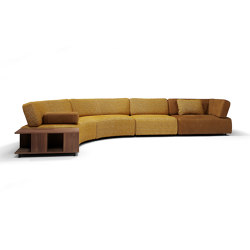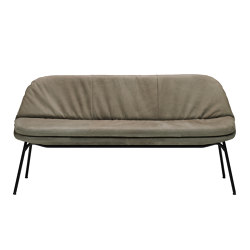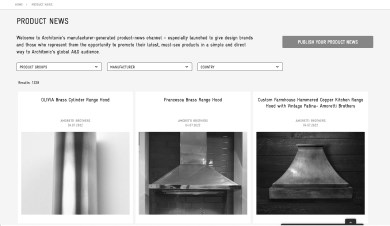About Bonacina 1889
MORE ABOUT BONACINA 1889
PROFILE
Certain names and dates distinguish the life of a company just as they distinguish the life of each one of us:
1889 • Giovanni Bonacina and the tradition of the past
1951 • Vittorio Bonacina and the revolution with Franco Albini
1980 • Mario Bonacina and the design for the future
Gestures and fragrances accompany each phase of an activity and those of the Bonacina family in particular: it is their skill in wetting, bending and drying and the aroma of those far off countries emitting from the canes of India, Manau and Manila.
Movements unchanged in time serve a design that springs from the material itself: nothing like rattan imposes such a precise, studied choice and thus old and modern combined. Know-how and avant-gardism have always been in the Bonacina family’s dna.
In Lurago d’Erba Giovanni treasured the ancient craft of basket making and, more than a century ago, he founded his company. Production soon extended to armchairs, living-room furniture and furnishings. Success very quickly followed with international acknowledgement in 1909 in London and in Paris and again in Rome in 1910 and important commissions such as the furnishing of the Grand Hotel Villa d’Este in Cernobbio (Como).
The furnishing of patrician villas continued during the whole of the 1940’s making Bonacina the most important Italian company producing rattan and rattan core furniture at that time.
When Franco Albini was given the assignment in 1951 to design two armchairs, the architect turned without hesitation to Vittorio Bonacina who had acquired great experience at his father’s side. Presentation of the revolutionary “Margherita” at the IX Triennial - awarded with the gold medal - was a memorable moment for the world of design and the beginning of a new life for the company, the first step towards a profitable relationship with great designers.
A rich archive of designs and prototypes preserves with care and passion the
collaboration between master craftsmen and names that have made design history in Italy and throughout the world:
Albini, Aulenti, Forges Davanzati, Gregotti, Mongiardino, Ponti, Sambonet, Travasa... a difficult road but courageous and stimulating at the same time. Intuition and outstanding quality that has always been recognised at the “Triennale”, at the “Compassi d’Oro” from the 1950’s onwards, up until the most important design shows of the 1990’s and of our century around the world. A special place is reserved for famous pieces such as the “Palla”, the “Margherita” and the “Gala” in museums such as the M.O.M.A. in New York, the Museum of Art in Philadelphia, the Montreal Museum of Fine Arts in Montreal, the Vitra Design Museum in Weil Am Rhein and the Museo del Design at the Triennale in Milano. Once again the list of private and public works where Vittorio Bonacina was chosen as a partner to lend importance to their furnishings is endless: the Musee d’Orsay in Paris, realized by Gae Aulenti, is a striking example, as well as the more recent Sanderson Hotel in London, designed by Philippe Starck or the Hotel Le Sirenuse in Positano and the Hotel Caruso in Ravello.
Mario Bonacina, designer, managerial soul and a living memory of the company’s family history is the author of this transition. It was his idea to re-propose some memorable pieces, updating them and pushing to always go “beyond” the intrinsic qualities of the raw materials used, just as his father had done before him. Thus, collaboration with the latest generation of designers began – Bettoni, Colombo, Cananzi, Marco Zanuso jr... – and the combining of wood and metal with rattan and rattan core. At the same time, the process of sensitizing the clientele towards natural furnishings and to the ecological advantages of careful water painting has continued.
The long path of research, in-depth studies and experimentation carried out on an individual type of material has given an accurate connotation to the company since the end of the 1990’s. Consistent with his ability to work with “mono-materials”, Mario has created a point of strength with his past, with each new collection asserting the cultural aim of his message, beyond any fashion: the rattan core is seen, studied and seen again through the eyes of different designers. The passion and the exclusively Italian craftsmanship of the material, filtered down through the family’s experience, allow these designers to be open to ideas and to the innovative ferment of contemporary design.
After more than a century, the Vittorio Bonacina name continues to be synonymous with products of the highest quality, both formal and aesthetical, throughout the world.
MATERIALS:
THE RATTAN
is a natural material which grows mainly in the Far East and reaches us after having been rigorously selected. We use it to manufacture our furniture.
Its characteristics are elasticity, flexibility and lightness. Woven by hand with knowledge and experience by our highly specialized artisans we produce pieces of furniture of elegance and lasting durability.
THE CANE
can be used in its entirety or divided by special procedures to draw out the inner core from the outer skin, enabling the skin and the core to be use separately.
RATTAN WHITHOUT SKIN
can be heated over an open flame (just like the natural rattan with skin) it is used to manufacture pieces which can then be coloured at a later point.
Once the skin is separated from the core it can be used for reinforcing and decorating purposes.
RATTAN-CORE
After being dipped in water the skin becomes soft and can be woven like the rattan-core, it has a warm honey-colour and it remains in its natural colour.
During the extraction process the rattan-core ca be obtained in different diameters or in a flat-oval section. Once soaked in water it can be woven in a large variety of designs and can be painted in any colour.
THE PULUT
is a small variety of the larger rattan cane, it has a reddish colour and it is used in its entirety. It also stays in its natural colour.
PROFILE
Certain names and dates distinguish the life of a company just as they distinguish the life of each one of us:
1889 • Giovanni Bonacina and the tradition of the past
1951 • Vittorio Bonacina and the revolution with Franco Albini
1980 • Mario Bonacina and the design for the future
Gestures and fragrances accompany each phase of an activity and those of the Bonacina family in particular: it is their skill in wetting, bending and drying and the aroma of those far off countries emitting from the canes of India, Manau and Manila.
Movements unchanged in time serve a design that springs from the material itself: nothing like rattan imposes such a precise, studied choice and thus old and modern combined. Know-how and avant-gardism have always been in the Bonacina family’s dna.
In Lurago d’Erba Giovanni treasured the ancient craft of basket making and, more than a century ago, he founded his company. Production soon extended to armchairs, living-room furniture and furnishings. Success very quickly followed with international acknowledgement in 1909 in London and in Paris and again in Rome in 1910 and important commissions such as the furnishing of the Grand Hotel Villa d’Este in Cernobbio (Como).
The furnishing of patrician villas continued during the whole of the 1940’s making Bonacina the most important Italian company producing rattan and rattan core furniture at that time.
When Franco Albini was given the assignment in 1951 to design two armchairs, the architect turned without hesitation to Vittorio Bonacina who had acquired great experience at his father’s side. Presentation of the revolutionary “Margherita” at the IX Triennial - awarded with the gold medal - was a memorable moment for the world of design and the beginning of a new life for the company, the first step towards a profitable relationship with great designers.
A rich archive of designs and prototypes preserves with care and passion the
collaboration between master craftsmen and names that have made design history in Italy and throughout the world:
Albini, Aulenti, Forges Davanzati, Gregotti, Mongiardino, Ponti, Sambonet, Travasa... a difficult road but courageous and stimulating at the same time. Intuition and outstanding quality that has always been recognised at the “Triennale”, at the “Compassi d’Oro” from the 1950’s onwards, up until the most important design shows of the 1990’s and of our century around the world. A special place is reserved for famous pieces such as the “Palla”, the “Margherita” and the “Gala” in museums such as the M.O.M.A. in New York, the Museum of Art in Philadelphia, the Montreal Museum of Fine Arts in Montreal, the Vitra Design Museum in Weil Am Rhein and the Museo del Design at the Triennale in Milano. Once again the list of private and public works where Vittorio Bonacina was chosen as a partner to lend importance to their furnishings is endless: the Musee d’Orsay in Paris, realized by Gae Aulenti, is a striking example, as well as the more recent Sanderson Hotel in London, designed by Philippe Starck or the Hotel Le Sirenuse in Positano and the Hotel Caruso in Ravello.
Mario Bonacina, designer, managerial soul and a living memory of the company’s family history is the author of this transition. It was his idea to re-propose some memorable pieces, updating them and pushing to always go “beyond” the intrinsic qualities of the raw materials used, just as his father had done before him. Thus, collaboration with the latest generation of designers began – Bettoni, Colombo, Cananzi, Marco Zanuso jr... – and the combining of wood and metal with rattan and rattan core. At the same time, the process of sensitizing the clientele towards natural furnishings and to the ecological advantages of careful water painting has continued.
The long path of research, in-depth studies and experimentation carried out on an individual type of material has given an accurate connotation to the company since the end of the 1990’s. Consistent with his ability to work with “mono-materials”, Mario has created a point of strength with his past, with each new collection asserting the cultural aim of his message, beyond any fashion: the rattan core is seen, studied and seen again through the eyes of different designers. The passion and the exclusively Italian craftsmanship of the material, filtered down through the family’s experience, allow these designers to be open to ideas and to the innovative ferment of contemporary design.
After more than a century, the Vittorio Bonacina name continues to be synonymous with products of the highest quality, both formal and aesthetical, throughout the world.
MATERIALS:
THE RATTAN
is a natural material which grows mainly in the Far East and reaches us after having been rigorously selected. We use it to manufacture our furniture.
Its characteristics are elasticity, flexibility and lightness. Woven by hand with knowledge and experience by our highly specialized artisans we produce pieces of furniture of elegance and lasting durability.
THE CANE
can be used in its entirety or divided by special procedures to draw out the inner core from the outer skin, enabling the skin and the core to be use separately.
RATTAN WHITHOUT SKIN
can be heated over an open flame (just like the natural rattan with skin) it is used to manufacture pieces which can then be coloured at a later point.
Once the skin is separated from the core it can be used for reinforcing and decorating purposes.
RATTAN-CORE
After being dipped in water the skin becomes soft and can be woven like the rattan-core, it has a warm honey-colour and it remains in its natural colour.
During the extraction process the rattan-core ca be obtained in different diameters or in a flat-oval section. Once soaked in water it can be woven in a large variety of designs and can be painted in any colour.
THE PULUT
is a small variety of the larger rattan cane, it has a reddish colour and it is used in its entirety. It also stays in its natural colour.
MORE ABOUT BONACINA 1889


















